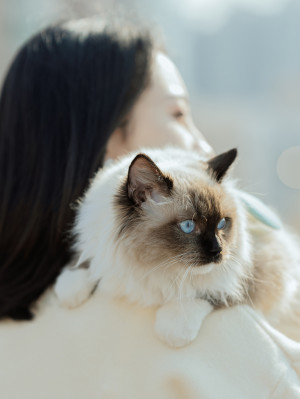Scientists Finally Discovered the Gene That Makes Cats Orange
Ginger, calico, and tortoiseshell cats have been a mystery for 60 years.

Share Article
We know what orange cats are: adorable, ginger balls of perfection — and if you ask the internet, endearingly ridiculous agents of chaos. But for years, we have had no idea why orange cats are, in fact, orange. As in, what genetically makes a cat a redhead? Now, scientists have finally discovered the gene behind all that orange fur.
Scientists (and cat lovers) have long been fascinated by orange cats, their cheeky personalities (okay maybe that's not the scientific part), and the fact that 80 percent of them are male. According to Science, researchers have spentopens in new tab the last 60 years trying to get to the bottom of this mystery. And now, two separate teams were able to find the ginger genetic mutation, a protein that influences hair “in a way never seen before in any animal.”
While most orange cats are male, the great majority of tortoiseshell and calico cats — the cross between black cats and orange cats — are female. This suggested to scientists that the gene variant that makes fur black or orange is on the X chromosome, because males inherit just one X chromosome, while females inherit an X chromosome from each parent.
In humans, “genetic variations in MC1R are associated with red hair and fair skin,” wrote Hidehiro Toh, the lead author of one of the groundbreaking studiesopens in new tab, wrote. But MC1R isn’t located on the X chromosome in cats and most orange cats don’t have MC1R mutations, so it couldn’t explain their ginger hair. Something else was at play, scientists realized.
After taking samples from four orange and four non-orange cats and scanning a database of 188 cat genomes, one team of researchersopens in new tab found an identical mutation in orange, calico, and tortoiseshell cats. They found that melanocytes (cells that produce melanin) in orange cats made 13 times as much RNA from ARHGAP36, a gene on the X chromosome. They didn’t find mutations in the DNA that creates ARHGAP36, but they found a missing stretch of DNA nearby that may affect how much ARHGAP36 is produced, Science explained.
Another study published this monthopens in new tab supported this, finding the mutation in 258 cat genomes. Additionally, they found that skin from calico cats “had more ARHGAP36 RNA in orange regions than in brown or black region,” Science reported.
Both studies found that increasing the amount of Arhgap36 in melanocytes caused cells to create light red pigment. “I am fully convinced this is the gene and am happy,” Carolyn Brown, a University of British Columbia geneticist,opens in new tab told Science. “It’s a question I’ve always wanted the answer to.”
As for the association between orange fur and total feline havoc? Some things may forever be mysteries.

Sio Hornbuckle
Sio Hornbuckle is the Assistant Editor at Kinship, where they frequently write for the site. As a writer, they specialize in pet news, animal science, and pop culture. They live in New York City with their cat, Toni Collette.
Related articles
![A cute orange tabby kitten playing with feathers.]()
Is Orange Cat Behavior Real? The Truth Behind the TikTok Trend
Your TikTok algorithm would like you to think so, but the experts weigh in.
![Phineas the cat, who has cerebellar hypoplasia, sitting on a chair at home.]()
“Wobbly Cat Syndrome” Is All Over the Internet—But What Are These Cats Really Like?
The pet parents of Phineas, a beloved social media star, tell us all about living with a cat with cerebellar hypoplasia.
![Short haired woman holding a gray cat that's playfully pawing at her nose]()
Does Your Cat’s Fur Pattern Determine Their Personality?
It’s a little more complicated than that.
![White and light brown cat laying down with eyes almost closed]()
Study Says “Slow Blinking” at Your Cat Helps You Bond
A team of psychologists at the Universities of Sussex and Portsmouth have discovered the key to building a bond with cats.
![Dark-haired woman holding her ragdoll cat]()
7 “Purebred” Cat Breeds Likely to Suffer from Genetic Disorders
Especially while shelters are overcrowded, consider adopting a cat.




